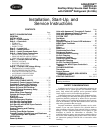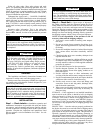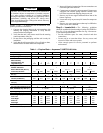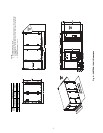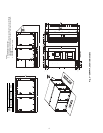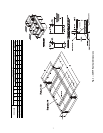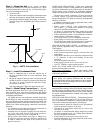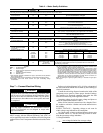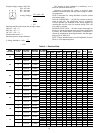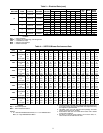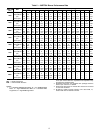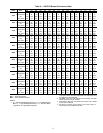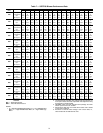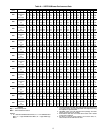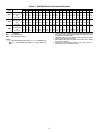
9
Table 2 — Water Quality Guidelines
LEGEND
*Heat exchanger materials considered are copper, cupronickel, 304 SS (stainless
steel), 316 SS, titanium.
†Closed recirculating system is identified by a closed pressurized piping system.
**Recirculating open wells should observe the open recirculating design
considerations.
††If the concentration of these corrosives exceeds the maximum allowable level,
then the potential for serious corrosion problems exists.
Sulfides in the water quickly oxidize when exposed to air, requiring that no agita-
tion occur as the sample is taken. Unless tested immediately at the site, the sam-
ple will require stabilization with a few drops of one Molar zinc acetate solution,
allowing accurate sulfide determination up to 24 hours after sampling. A low pH
and high alkalinity cause system problems, even when both values are within
ranges shown. The term pH refers to the acidity, basicity, or neutrality of the water
supply. Below 7.0, the water is considered to be acidic. Above 7.0, water is con-
sidered to be basic. Neutral water contains a pH of 7.0.
NOTE: To convert ppm to grains per gallon, divide by 17. Hardness in mg/l is equiv-
alent to ppm.
Step 7 — Connect Electrical Wiring
All field installed wiring, including the electrical ground,
MUST comply with the National Electrical Code (NEC) as
well as applicable local codes. In addition, all field wiring must
conform to the Class II temperature limitations described in the
NEC.
Refer to unit wiring diagrams in Fig. 6-16 for a schematic of
the field connections which must be made by the installing (or
electrical) contractor.
Consult the unit wiring diagram located on the inside of the
compressor access panel to ensure proper electrical hookup.
The installing (or electrical) contractor must make the field
connections when using field-supplied disconnect.
Operating voltage must be the same voltage and phase as
shown in electrical data shown in Table 3.
Make all final electrical connections with a length of flexi-
ble conduit to minimize vibration and sound transmission to
the building.
SUPPLY VOLTAGE — Operating voltage to unit must be
within voltage range indicated on unit nameplate.
On 3-phase units, voltages under load between phases must
be balanced within 2%. Use the following formula to deter-
mine the percentage voltage imbalance:
% Voltage Imbalance
CONDITION
HX
MATERIAL*
CLOSED RECIRCULATING† OPEN LOOP AND RECIRCULATING WELL**
Scaling Potential — Primary Measurement
Above the given limits, scaling is likely to occur. Scaling indexes should be calculated using the limits below.
pH/Calcium
Hardness Method
All N/A pH < 7.5 and Ca Hardness, <100 ppm
Index Limits for Probable Scaling Situations (Operation outside these limits is not recommended.)
Scaling indexes should be calculated at 150 F for direct use and HWG applications, and at 90 F for indirect HX use. A monitoring plan should be
implemented.
Ryznar Stability Index
All N/A
6.0 - 7.5
If >7.5 minimize steel pipe use.
Langelier Saturation Index
All N/A
–0.5 to +0.5
If <–0.5 minimize steel pipe use.
Based upon 150 F HWG and direct well, 85 F indirect well HX.
Iron Fouling
Iron Fe
2+
(Ferrous)
(Bacterial Iron Potential)
All N/A
<0.2 ppm (Ferrous)
If Fe
2+
(ferrous) >0.2 ppm with pH 6 - 8, O
2
<5 ppm check for iron bacteria.
Iron Fouling
All N/A
<0.5 ppm of Oxygen
Above this level deposition will occur.
Corrosion Prevention††
pH
All
6 - 8.5
Monitor/treat as needed.
6 - 8.5
Minimize steel pipe below 7 and no open tanks with pH <8.
Hydrogen Sulfide (H
2
S)
All N/A
<0.5 ppm
At H
2
S>0.2 ppm, avoid use of copper and cupronickel piping or HXs.
Rotten egg smell appears at 0.5 ppm level.
Copper alloy (bronze or brass) cast components are okay to <0.5 ppm.
Ammonia Ion as Hydroxide,
Chloride, Nitrate and Sulfate
Compounds
All N/A
<0.5 ppm
Maximum Chloride Levels Maximum allowable at maximum water temperature.
50 F (10 C) 75 F (24 C) 100 F (38 C)
Copper N/A
<20 ppm NR NR
CuproNickel N/A <150 ppm NR NR
304 SS N/A <400 ppm <250 ppm <150 ppm
316 SS N/A <1000 ppm <550 ppm <375 ppm
Titanium N/A >1000 ppm >550 ppm >375 ppm
Erosion and Clogging
Particulate Size and Erosion
All
<10 ppm of particles and a max-
imum velocity of 6 fps. Filtered
for maximum
800 micron size.
<10 ppm (<1 ppm “sand free” for reinjection) of particles and a maximum velocity of 6
fps. Filtered for maximum 800 micron size. Any particulate that is not removed can
potentially clog components.
HWG — Hot Water Generator
HX — Heat Exchanger
N/A — Design Limits Not Applicable Considering Recirculating
Potable Water
NR — Application Not Recommended
SS — Stainless Steel
WARNING
Electrical shock can cause personal injury and death. Shut
off all power to this equipment during installation. There
may be more than one disconnect switch. Tag all discon-
nect locations to alert others not to restore power until work
is completed.
CAUTION
Use only copper conductors for field-installed electrical
wiring. Unit terminals are not designed to accept other
types of conductors.
= 100 x
max voltage deviation from average voltage
average voltage



